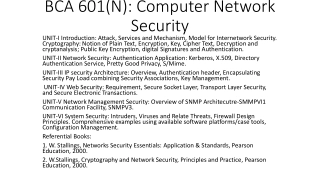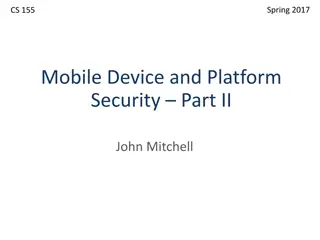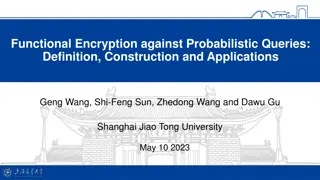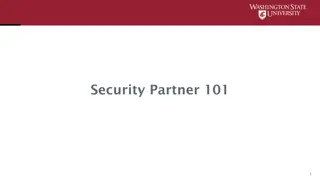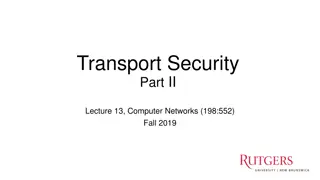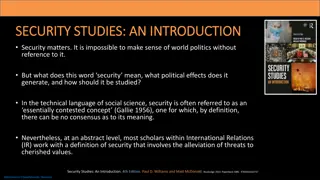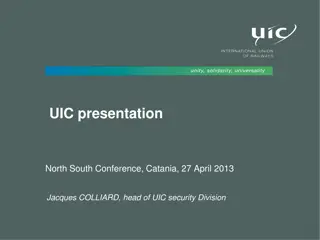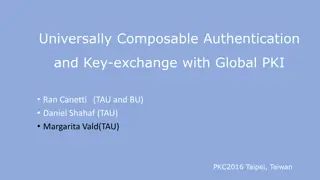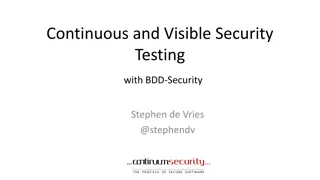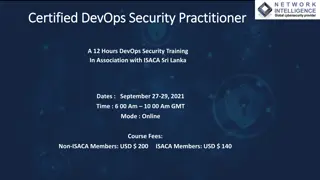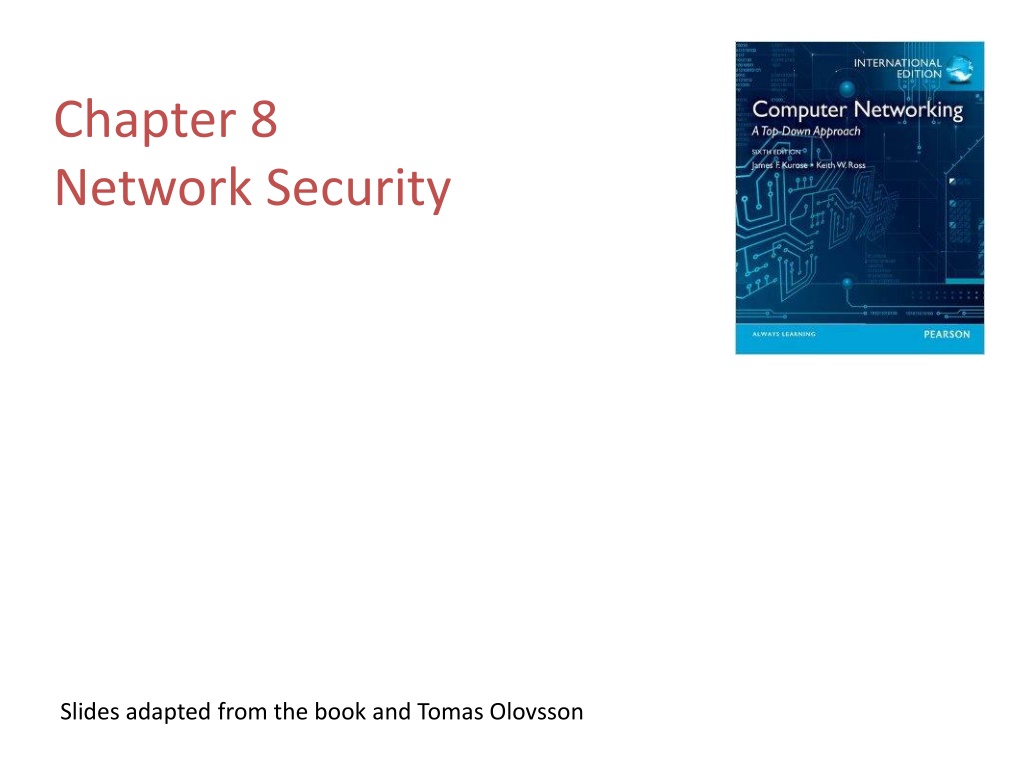
Understanding Network Security Principles and Countermeasures
"Discover essential network security concepts such as confidentiality, integrity, and availability, along with common threats like packet sniffing and IP spoofing. Learn effective countermeasures to protect your network from vulnerabilities and ensure secure communication." (Approximately 318 characters)
Download Presentation

Please find below an Image/Link to download the presentation.
The content on the website is provided AS IS for your information and personal use only. It may not be sold, licensed, or shared on other websites without obtaining consent from the author. Download presentation by click this link. If you encounter any issues during the download, it is possible that the publisher has removed the file from their server.
E N D
Presentation Transcript
Chapter 8 Network Security Slides adapted from the book and Tomas Olovsson
Roadmap 8.1 What is network security? 8.2 Principles of cryptography 8.3 Message integrity Security protocols and measures: Securing TCP connections: SSL Network layer security: IPsec Firewalls Network Layer 4-2
What is security? CIA! Confidentiality: only sender, intended receiver should understand message contents sender encrypts message receiver decrypts message Integrity: sender, receiver want to ensure message not altered (in transit, or afterwards) without detection Availability: services must be accessible and available to users The book also includes Authentication: it is normally seen as a mechanism to implement the services above 8-3
Internet security threats Packet sniffing: broadcast media promiscuous NIC reads all packets passing by can read all unencrypted data (e.g. passwords) e.g.: C sniffs B s packets C A src:B dest:A payload B Countermeasures? 8-4
Internet security threats Packet sniffing: countermeasures One host per segment of broadcast media Use switches (not hubs) Segment network Use routers Encryption switch A B C 8-5
Internet security threats IP Spoofing: can generate raw IP packets directly from application, putting any value into IP source address field receiver can t tell if source is spoofed, e.g.: C pretends to be B C A src:B dest:A payload B Countermeasures? 8-6
Internet security threats IP Spoofing: ingress filtering routers should not forward incoming and outgoing packets with invalid addresses Outgoing datagram source address not in router s network (egress filtering) Incoming datagram has internal address as source address (ingress filtering) C A B src:B dest:A payload 8-7
Communication threats Summary Impersonation (identity spoofing) Data origin spoofing Impersonation (identity spoofing) Data origin spoofing Eavesdropping (passive) Modification Insertion, Deletion Delay, Replay, Flood Server Alice Client Bob
Roadmap 8.1 What is network security? 8.2 Principles of cryptography 8.3 Message integrity Security protocols and measures: Securing TCP connections: SSL Network layer security: IPsec Firewalls Network Layer 4-9
The language of cryptography Alice s encryption key Bob s decryption key KA KB encryption algorithm decryption algorithm ciphertext plaintext plaintext Trudy Symmetric key crypto: sender & receiver keys identical Asymmetric key crypto (or Public-key crypto): One key for encryption, another for decryption. One of the keys can be public, the other private. 8-10
Symmetric key cryptography KA-B KA-B encryption algorithm decryption algorithm ciphertext plaintext m = K ( plaintext message, m ) K (m) A-B K (m) A-B A-B symmetric key crypto: Bob and Alice share the same (symmetric) key: K A-B Q: how do Bob and Alice agree on key value? 8-11
Block Encryption (ECB mode) Block size depends on cipher: DES=64 bits, AES=128 bits, Independent of key length. Plaintext block Symmetric Key (encrypts and decrypts) The algorithm is publicly known! Block cipher Problem: same plaintext always results in the same ciphertext ( block effect ) This mode is called electronic codebook mode (ECB) Ciphertext block (same size) Chapter 6.2
CBC Cipher block chaining mode Identical blocks now encrypted differently. Plaintext May not always be practical, for example for hard disk encryption. IV init. vector for first block f Block cipher Note that there is no protection against replays and alteration! Ciphertext Chapter 6.3
ECB vs. CBC Identical blocks give identical results
Symmetric Key Ciphers DES (Data Encryption Standard) Designed by IBM 1975, Adopted by NIST* 1977 Criticized for key length (64 56) and mysterious S-boxes Turned out to have protection against differential cryptanalysis (found 1990) Probably more effort is spent on cracking DES than on all other ciphers together Today key length is a major problem: 56-bit keys can be cracked EFF DES cracker. Jan 19, 1999: 22h15m 3-DES (repeating DES three times with different keys) 3-DES probably secure today but too computational intensive AES (Advanced Encryption Standard) Replaces DES as of 2001 Result of an official competition Key lengths: 128, 192 or 256 bits Brute force decryption: if DES takes 1 second, AES-128 takes 149 trillion years, AES-256 would take 1052years *NIST = National Institute of Standards and Technology, US, formerly NBS RC4, RC5, RC6 RC4 is considered weak but it is fast
Key Length and Number of Possible Keys Key Length in Bits Number of Possible Keys 1 2 2 4 1,099,511,627,776 40 72,057,594,037,927,900 56 112 5,192,296,858,534,830,000,000,000,000,000,000 168 3.74144E+50 256 1.15792E+77 512 1.3408E+154 Figure 7-3 8-16
Asymmetric key encryption One key is used to encrypt, the other to decrypt One key can be public the other kept secret Based on mathematically hard problems Factorization of very large primes (RSA) Slow because of the large numbers involved 1024 bits and up (RSA), 384 bits (ECC) 21024= 10308which means >300 digit numbers Ciphers: RSA Rivest, Shamir, Adleman (Patent expired 2000) ECC Elliptic Curve Cryptosystem 768-bit RSA was reported cracked Jan 2010: They generated a five-terabyte decryption table. It would have taken around 1,500 years using a single AMD Opteron-based PC (they used a cluster) 1024-bit RSA is too short to protect against extremely large organizations Use 2048-bit RSA keys in sensitive applications "the overall effort [as] sufficiently low that even for short-term protection of data of little value, 768- bit RSA moduli can no longer be recommended."
Asymmetric key encryption 1 One key is normally made public ( Public key encryption ) 2 You decide whether it is the encryption or decryption key that is public: 1. Encryption key public: everyone can send encrypted messages to owner of the private key 2. Decryption key public: only one can encrypt, everyone can verify that the secret key has been used. Can be used to sign documents and data. Useful? 8-18
Example 1: Public Key Encryption + Bob s public key Bob s private key K B - K B encryption algorithm decryption algorithm plaintext message m = K (K (m)) B plaintext message, m ciphertext K (m) B + - + B 8-19
Example 2: Digital Signatures Simple digital signature for message m: Bob signs m by encrypting with his private key KB, creating signed message, KB(m) - - - Bob s private key Bob s message, m: K B Dear Alice Oh, how I have missed you. I think of you all the time! (blah blah blah) Bob Bob s message, Bob s message, m, m, in clear in clear- -text Public key encryption algorithm text Signature = Message encrypted with Bob s private key -(m) K B 8-20
Relative performance Hash functions SHA-512 SHA-1 MD5 Symmetric ciphers 200-1,000 Mbyte/s RC4 AES DES 3-DES 100 Mbyte/s Asymmetric ciphers RSA Use asymmetric algorithms to agree on symmetric keys, symmetric algorithms for bulk data encryption, and hash functions for integrity protection if encryption is not needed 0.1 Mbyte/s
Roadmap 8.1 What is network security? 8.2 Principles of cryptography 8.3 Message integrity Security protocols and measures: Securing TCP connections: SSL Network layer security: IPsec Firewalls Network Layer 4-22
Message Integrity Bob receives msg from Alice, wants to ensure: message originally came from Alice message not changed since sent by Alice Just encryption is not enough! Contents can be changed even if it is encrypted Solution: add some kind of checksum (hash) to the message before it is encrypted: Data packet (payload) Hash Encrypted packet 8-23
(Cryptographic) hash functions Input: arbitrary length bit-string Output: fixed length bit-string Not a one-to-one mapping, output space typically 128 bits Requirements: Computationally efficient: Typically >10 times faster than symmetric ciphers Must be repeatable (same input same output) Impossible to reverse the computation (preimage resistant) Infeasible to find an input X with a given hash Infeasible to find two inputs resulting in the same hash (pseudo- randomness) Today s hash functions are not based on mathematical foundations may lead to problems f(x) hash x SSL broken! Hackers create rogue CA certificate using MD5 collisions [www.zdnet.com]
Hash functions input Even a single bit change should give a completely different result avalanche effect SHA-512 has 80 rounds Non-linear function
Hash functions Even just one changed bit gives a completely different result: md5( hello ) = 5d41402abc4b2a76b9719d911017c592 md5( Hello ) = 8b1a9953c4611296a827abf8c47804d7 MD5 Message Digest 5 (RFC 1321, 1992) 128-bit message digest 1038different hashes Avoid in new implementations - weak As of 2012, an estimat- ed cost of $2.77M to break a single hash value by renting CPU power from cloud servers. - SHA-1, Wikipedia SHA-1 Secure Hash Algorithm Designed by NSA, became NIST standard 1995: FIPS-180-2 160-bit message digest 1048different hashes Avoid if collisions may cause problems in application, otherwise ok SHA-2 (family name for SHA-224, SHA-256, SHA-384 and SHA-512) Similar design as SHA-1, but at least today SHA-1 attacks not applicable SHA-3 next generation hash functions Keccak - winner of open competition (NIST draft 2014) Arbitrary digest size (standard proposes 224, 256, 384 and 512 bit digests)
Keyed Hash No need to encrypt message s shared secret (not sent) s message message message H(m+s) compare H(m+s) Authenticates sender Verifies message integrity No encryption ! Example: HMAC (Key-Hashing for Message Authentiction)
End point (User) Authentication Alice says I am Alice and sends her secret password to prove it. (Just like the FTP protocol) Alice s password I m Alice Failure scenario?? OK 8-28
End point (User) Authentication Alice says I am Alice and sends her secret password to prove it. Alice s password I m Alice playback attack: Trudy records Alice s packet and later plays it back to Bob Alice s password I m Alice 8-29
Authentication: another try Another attempt: Alice says I am Alice and sends her encrypted secret password to prove it. encrypted password I m Alice Failure scenario?? OK record and playback still works! 8-30
Authentication: Challenge response Goal: avoid playback attack Nonce: number (R) used only once in-a-lifetime To prove Alice is live , Bob sends Alice nonce, R. Alice must return R, encrypted with shared secret key I am Alice R Alice is live, and only Alice knows key to encrypt nonce, so it must be Alice! K (R) A-B Failures, drawbacks? 8-31
Summary Encryption for confidentiality Hashes for data integrity Sequence numbers for replay protection Authentication (mutual) for identity protection Symmetric encryption for bulk data Asymmetric encryption for key negotiation
Roadmap 8.1 What is network security? 8.2 Principles of cryptography 8.3 Message integrity Security protocols and measures: Securing TCP connections: SSL Network layer security: IPsec Firewalls Application SSL TCP IP Network Layer 4-33
SSL: Secure Sockets Layer widely deployed security protocol supported by almost all browsers, web servers https billions $/year over SSL mechanisms: [Woo 1994], implementation: Netscape variation -TLS: transport layer security, RFC 2246 provides confidentiality integrity authentication original goals: Web e-commerce transactions encryption (especially credit-card numbers) Web-server authentication optional client authentication minimum hassle in doing business with new merchant available to all TCP applications secure socket interface Network Security 8-34
SSL and TCP/IP Application Application SSL TCP TCP IP IP normal application application with SSL SSL provides application programming interface (API) to applications C and Java SSL libraries/classes readily available Network Security 8-35
Real SSL connection everything henceforth is encrypted TCP FIN follows Network Security 8-36
SSL record protocol data data fragment data fragment MAC MAC encrypted data and MAC encrypted data and MAC record header record header record header: content type; version; length MAC: includes sequence number, MAC key Mx fragment: each SSL fragment 214bytes (~16 Kbytes) Network Security 8-37
What is network-layer confidentiality ? between two network entities: sending entity encrypts datagram payload, payload could be: TCP or UDP segment, ICMP message, OSPF message . all data sent from one entity to other would be hidden: web pages, e-mail, P2P file transfers, TCP SYN packets IPsec 8-38 IPsec
The two modes of IPSec IPsec IPsec IPsec IPsec Tunnel mode edge routers IPsec-aware protects communication gw-to-gw (over Internet) Virtual Private Network (VPN) Transport mode hosts IPsec-aware protects communication all the way from end-to- end Network Security 8-39
IPsec services data integrity confidentiality origin authentication replay attack prevention two protocols providing different service models: Authentication Header (AH) protocol provides source authentication & data integrity but not confidentiality Encapsulation Security Protocol (ESP) provides source authentication, data integrity, and confidentiality more widely used than AH Network Security 8-40
Virtual Private Networks (VPNs) motivation: institutions often want private networks for security. costly: separate routers, links, DNS infrastructure. VPN: institution s inter-office traffic is sent over public Internet instead encrypted before entering public Internet logically separate from other traffic Network Security 8-41
Virtual Private Networks (VPNs) laptop w/ IPsec public Internet salesperson in hotel router w/ IPv4 and IPsec router w/ IPv4 and IPsec branch office headquarters Network Security 8-42
What happens? Internet headquarters branch office 200.168.1.100 193.68.2.23 security association R1 R2 172.16.1/24 172.16.2/24 before sending data, security association (SA) established from sending to receiving entity enchilada authenticated encrypted new IP header ESP hdr original IP hdr Original IP datagram payload ESP trl ESP auth pad length next header Seq # padding SPI Network Security 8-43
Firewalls firewall isolates organization s internal net from larger Internet, allowing some packets to pass, blocking others public Internet untrusted bad guys administered network trusted good guys firewall Network Security 8-44
Firewalls: why prevent denial of service attacks: SYN flooding: attacker establishes many bogus TCP connections, no resources left for real connections prevent illegal modification/access of internal data e.g., attacker replaces CIA s homepage with something else allow only authorized access to inside network set of authenticated users/hosts three types of firewalls: stateless packet filters stateful packet filters application gateways Network Security 8-45
Security Courses at Chalmers http://www.cse.chalmers.se/edu/master/secspec/ Computer Security EDA 263 Network Security EDA 491 Cryptography TDA 352 Language based security TDA 602 Fault Tolerant Computer Systems EDA 122 8-46
Some review questions What is the difference between symmetric and asymmetric cryptography? Give examples of applications where each can be applied. Can you decrypt a hash of a message to get the original message? Explain your answer. What is the purpose of a nonce in an end-point authentication protocol? What is the main property of a nonce? 8-47
Reading instructions Kurose Ross (Course book) 8.1 8.4, 8.6, 8.7, 8.9.1 Other resources (extra material): http://shattered.it/ - information about practical SHA-1 collision https://thehackernews.com/ - security news 8-48

